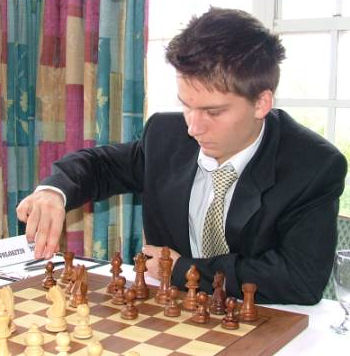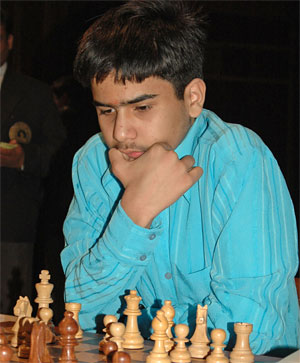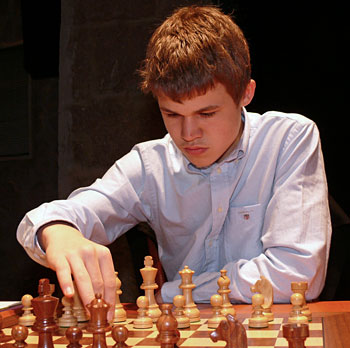| Latest | Greatest | Lobby | Journals | Search | Options | Help | Login |
|
|
|
This topic is archived. |
| Home » Discuss » Topic Forums » Sports |
|
| Jack Rabbit
|
Sun Apr-22-07 03:31 PM Original message |
| The Jack Rabbit Chess Report for April 22 |
|
Edited on Sun Apr-22-07 03:52 PM by Jack Rabbit
The Jack Rabbit Chess Report for the week ending April 22  Contents Post 1: http://www.democraticunderground.com/discuss/duboard.php?az=show_mesg&forum=215&topic_id=47898&mesg_id=47899">News for the week Post 2: http://www.democraticunderground.com/discuss/duboard.php?az=show_mesg&forum=215&topic_id=47898&mesg_id=47900">Diagrams and other features Post 3: http://www.democraticunderground.com/discuss/duboard.php?az=show_mesg&forum=215&topic_id=47898&mesg_id=47901">Games from Current and Recent Events |
| Printer Friendly | Permalink | | Top |
| Jack Rabbit
|
Sun Apr-22-07 03:32 PM Response to Original message |
| 1. News for the week ending April 22 |
|
Edited on Sun Apr-22-07 03:35 PM by Jack Rabbit
Cheparinov leads in Malmø
 The 15th annual Sigeman & Co. chess tournament began Wednesday in Malmø, Skåne, on the southern coast of Sweden across the Sound from the environs of Copenhagen. Ivan Cheparinov of Bulgaria, who usually is noted for being Veselin Topalov's second, leads the event after five rounds with four points. He is followed by Swedish grandmasters Emanuel Berg and Tiger Hillarp=Persson with 3½ points each. Unofficial Cross Table Sigeman & Co. Tournament Malmø, Skåne (Sweden) -------------------------- 1 2 3 4 5 6 7 8 9 0 T- (W) .1 Ivan Cheparinov. . . . .- 1 ½ * ½ * * 1 1 1 4. (3) .2 Emanuel Berg . . . . . .0 - * * * 1 ½ * 1 1 3½ (3) .3 Tiger Hillarp-Persson. .½ * - * 1 ½ * * 1 ½ 3½ (2) .4 Parimarjan Negi. . . . .* * * - 0 ½ 0 1 1 * 2½ (2) .5 Pontus Carlsson. . . . .½ * 0 1 - 0 ½ * * ½ 2½ (1) .6 Vasilios Kotronias . . .* 0 ½ ½ * - 1 ½ * * 2½ (1) .7 Erwin L'Ami. . . . . . .* ½ * 1 ½ 0 - ½ * * 2½ (1) .8 Jan Timman . . . . . . .* * * 0 * ½ ½ - 0 1 2. (1) .9 Jonny Hector . . . . . .0 0 0 0 * * * 1 - * 1. (1) 10 Emil Hermansson. . . . .0 0 ½ * ½ * * 0 * - 1. (0) The Jack Rabbit Unofficial Cross Table uses games won as first tie break Gaudsal Tournament begins; Magnus leads  An international tournament in the mountain resort of Gausdal, Oppland (Norway) began Wednesday. Norway's leading grandmaster, 16-year-old Magnus Carlsen, leads after five rounds with 4 points, followed by 70-year-old Hungarian grandmaster Lajos Portisch with 3½ points. Unofficial Cross Table Chess Classic Gausdal, Oppland (Norway) -------------------------- 1 2 3 4 5 6 7 8 9 0 T- (W) .1 Magnus Carlsen . . . . .- * * * * ½ 1 ½ 1 1 4. (3) .2 Lajos Portisch . . . . .* - ½ 1 ½ ½ 1 * * * 3½ (2) .3 Irina Krush. . . . . . .* ½ - * ½ 1 0 * 1 * 3. (2) .4 Michal Krasenkow . . . .* 0 * - ½ ½ * * 1 1 3. (2) .5 Eduardas Rozentalis. . .* ½ ½ ½ - * 1 ½ * * 3. (1) .6 Alexey Dreev . . . . . .½ ½ 0 ½ * - * 1 * * 2½ (1) .7 Kjetil Lie . . . . . . .0 0 1 * 0 * - * * 1 2. (2) .8 Kaido Kulaots. . . . . .½ * * * ½ 0 * - ½ 1 2. (1) .9 Gawain Jones . . . . . .0 * 0 0 * * * ½ - ½ 1. (0) 10 Eric Moskow. . . . . . .0 * * 0 * * 0 0 ½ - .½ (0) The Jack Rabbit Unofficial Cross Table uses games won as first tie break Portisch, who was one of the world's elite grandmasters in the sixties and seventies, recently drew a six-game rapid match with another 70-year-old chess legend, former world champion Boris Spassky. Two Americans are participating in Gausdal: international master Irina Krush is tied for third place with 3 points after losing today to Norwegian grandmaster Kjetil Lie; and Eric Moskow, an untitled player, who has a half point so far. |
| Printer Friendly | Permalink | | Top |
| Jack Rabbit
|
Sun Apr-22-07 03:36 PM Response to Original message |
| 2. Diagrams and other features of the JR Chess Report |
|
!""""""""# $tMvWlVmT% $OoOoOoOo% $ + + + +% $+ + + + % $ + + + +% $+ + + + % $pPpPpPpP% $RnBqKbNr% /(((((((() White to move This position is a theoretical draw Does this picture make sense to you? If not, or if it looks like a bunch of Wingdings, please click here. Diagrams used in the Jack Rabbit Chess Report are made with Chess Merida, a true type font that is available as freeware at the above link. Also, the JR chess report makes the main variation in annotations more distinct and readable by putting it in red. A secondary variation, is in blue and other colors are used if needed. |
| Printer Friendly | Permalink | | Top |
| Jack Rabbit
|
Sun Apr-22-07 03:37 PM Response to Original message |
| 3. Games from current and recent events |
|
Edited on Sun Apr-22-07 03:50 PM by Jack Rabbit
Chess Games Analysis by JR and Fritz Andrei Volokitin - T. L. Petrosian, European Individual Championships, Round 3, Dresden Tatiana Kosintseva - Elina Danielian, European Individual Championships, Round 4, Dresden Elli Pähtz - Oksana Vozovich, European Individual Championships, Round 6, Dresden Jonny Hector - Parimarjan Negi, Sigeman & Co Tournament, Round 1, Malmø Kjetil Lie - Magnus Carlson, Chess Classic, Round 2, Gaudsal |
| Printer Friendly | Permalink | | Top |
| Jack Rabbit
|
Sun Apr-22-07 03:39 PM Response to Reply #3 |
| 4. A. Volokitin - T. L. Petrosian, Round 3, Dresden |
 Andrei Volokitin Andrei Volokitin vs. T. L. Petrosian European Individual Championships, Round 3 Dresden, April 2007 Open Sicilian Game: Najdorf-Scheveningen Defense (Rauzer Opening) 1. e4 c5 2. Nf3 d6 3. d4 cxd4 4. Nxd4 Nf6 5. Nc3 a6 6. Bg5 e6 7. f4 Nbd7 8. Qf3 Qc7 9. g4
Black: T. L. Petrosian !""""""""# $ +t+lV T% $+v+m+o+o% $o+ Oo+o+% $+ + + P % $ W NpP +% $+ N + +q% $ Pp+ + P% $+ KrRb+ % /(((((((() White: Andrei Volokitin Position after 18. -- g7g6 19. f5
Black: T. L. Petrosian !""""""""# $ +t+lV T% $+v+m+o+ % $o+ O PoO% $+ + O + % $ W +p+ +% $+nN R +q% $ Pp+ + P% $+ Kr+b+ % /(((((((() White: Andrei Volokitin Position after 22. -- h7h6 23. Nd5!?
Black: T. L. Petrosian !""""""""# $ + L V R% $+ + +o+ % $o+vO PoO% $+ WnO P % $ + +p+b+% $+ +rQ + % $ Pp+ + P% $+k+ + + % /(((((((() White: Andrei Volokitin Position after 32. Qb5c5 32. Rb3!!
|
| Printer Friendly | Permalink | | Top |
| Jack Rabbit
|
Sun Apr-22-07 03:41 PM Response to Reply #3 |
| 5. T. Kosintseva - Danielian, Round 4, Dresden |
|
Tanya won nine games in Dresden. This is one of her best.
 Tatiana Kosintseva Tatiana Kosintseva vs. Elina Danielian European Individual Championships, Round 4 Dresden, April 2007 Closed German Game: Tarrasch Opening (Caro-Kann Defense) 1. e4 c6 2. d4 d5 3. e5 Bf5 4. Nd2
Black: Elina Danielian !""""""""# $ +tW L T% $+o+ VoOo% $o+ +o+v+% $P +oPm+ % $qP + + +% $+ P +n+ % $ + +bPpP% $R B +rK % /(((((((() White: Tatiana Kosintseva Position after 15. -- Ke8f8 16. b5!
Black: Elina Danielian !""""""""# $ + + L T% $+oW VoOo% $ + +o+vM% $Pq+ + + % $ +o+ +p+% $B + +n+ % $ + +bP P% $R + + K % /(((((((() White: Tatiana Kosintseva Position after 22. -- Nf5h6 23. Bd6!
|
| Printer Friendly | Permalink | | Top |
| Jack Rabbit
|
Sun Apr-22-07 03:43 PM Response to Reply #3 |
| 6. E. Pähtz - Vozovich, Round 6, Dresden |
|
Elli Pähtz can always be depended upon to turn in some fine games whenever she plays.
 Elli Pähtz Elli Pähtz vs. Oksana Vozovich European Individual Championships, Round 6 Dresden, April 2007 Italian Royal Game: Neo-Classical Defense (Clam Opening) (Giucco Pianissimo) 1. e4 Nc6 2. Nf3 e5 3. Bc4 Bc5 4. c3 Nf6
Black: Oksana Vozovic !""""""""# $t+ +t+l+% $VoO +oO % $o+ + M O% $+ +wPp+ % $ + + O +% $+ P +n+p% $pPb+qP +% $R + K R % /(((((((() White: Elli Pähtz Position after 19. -- Qd8d5 20. Kf1!
Black: Oksana Vozovic !""""""""# $t+ + T K% $+ O + O % $o+ + MqO% $+o+ Pp+ % $ + + O +% $+bP +n+p% $pP +wPk+% $R + + R % /(((((((() White: Elli Pähtz Position after 25. -- Qd3e2 26. Kh2!! 1-0
|
| Printer Friendly | Permalink | | Top |
| Jack Rabbit
|
Sun Apr-22-07 03:45 PM Response to Reply #3 |
| 7. Hector - Negi, Round 1, Malmø |
|
Edited on Sun Apr-22-07 03:46 PM by Jack Rabbit
Here is a beutifully played endgame from the world's youngest grandmaster, 14-year-old Parimarjan Negi.
 Parimarjan Negi Jonny Hector vs. Parimarjan Negi Sigeman & Co Tournament, Round 1 Malmø, Skåne (Sweden), April 2007 Open Sicilian Game: Najdorf-Scheveningen Defense (Rauzer Opening) 1. e4 c5 2. Nf3 d6 3. d4 cxd4 4. Nxd4 Nf6 5. Nc3 a6 6. Bg5 e6 7. f4 Nbd7 8. Qf3 Qc7 9. g4
Black: Parimarjan Negi !""""""""# $t+ +l+ T% $+vW +oO % $o+ O + +% $+ +pMpV % $ Q N + +% $+ + + + % $pPp+ +b+% $+k+rR + % /(((((((() White: Jonny Hector Position after 22. Kc1b1 22. -- 0-0!
Black: Parimarjan Negi !""""""""# $ + + T +% $+ + + Ol% $ + O + V% $+ +p+o+ % $ P + + +% $+ + + + % $ +p+ + +% $K + +b+r% /(((((((() White: Jonny Hector Position after 38. ab4:p 38. -- g5!
Black: Parimarjan Negi !""""""""# $ + + + +% $+ + + + % $ +pV + +% $+ +pLo+ % $ + + + +% $+ + KbO % $ + + T +% $+ + R + % /(((((((() White: Jonny Hector Position after 56. Rc1e1 56. -- Bc5+!
Black: Parimarjan Negi !""""""""# $ + + + +% $+lP + R % $ + O + +% $+ V +o+b% $ + + + +% $+ +k+ + % $t+ + +o+% $+ + + + % /(((((((() White: Jonny Hector Position after 63. d5d6 63. -- Ra3+!
Black: Parimarjan Negi !""""""""# $ +l+ + +% $+ P + + % $ + O + +% $+ + +o+ % $ +b+t+ +% $+k+ + + % $ + + + +% $+ + + V % /(((((((() White: Jonny Hector Position after 73. Ka4b3 73. -- Rxc4!!
|
| Printer Friendly | Permalink | | Top |
| Jack Rabbit
|
Sun Apr-22-07 03:47 PM Response to Reply #3 |
| 8. K. Lie - Carlsen, Round 2, Gausdal |
 Magnus Carlsen Kjetil Lie vs. Magnus Carlsen Chess Classic, Round 2 Gausdal, Oppland (Norway), April 2007 Sicilian Clam Game: Grand Prix Opening 1. f4 c5 2. Nf3 Nf6 3. d3 Nc6 4. e4 d5
Black: Magnus Carlsen !""""""""# $t+ +lV T% $Oo+ WoOo% $ +m+o+ M% $+ + P Nq% $ + + P +% $+ Np+ + % $pPp+ +pP% $R B +rK % /(((((((() White: Kjetil Lie Position after 11. Nb1c3 11. -- 0-0-0!
Black: Magnus Carlsen !""""""""# $ +lT VmT% $Oo+ Wr+o% $ +m+o+ +% $+ Oo+ Pq% $ + + + +% $+ Np+ + % $pPp+ +pP% $+ + R K % /(((((((() White: Kjetil Lie Position after 16. Rf1f7 16. -- Qe8!!
Black: Magnus Carlsen !""""""""# $ +l+w+ +% $Oo+ + +m% $ +m+m+ +% $+ R + P % $ + B + +% $+ +p+ + % $pPp+ +pP% $+ + R K % /(((((((() White: Kjetil Lie Position after 26. Rf1e1 26. -- Qd7!
|
| Printer Friendly | Permalink | | Top |
| DU
AdBot (1000+ posts) |
Fri May 03rd 2024, 07:03 PM Response to Original message |
| Advertisements [?] |
| Top |
| Home » Discuss » Topic Forums » Sports |
|
Powered by DCForum+ Version 1.1 Copyright 1997-2002 DCScripts.com
Software has been extensively modified by the DU administrators
Important Notices: By participating on this discussion board, visitors agree to abide by the rules outlined on our Rules page. Messages posted on the Democratic Underground Discussion Forums are the opinions of the individuals who post them, and do not necessarily represent the opinions of Democratic Underground, LLC.
Home | Discussion Forums | Journals | Store | Donate
About DU | Contact Us | Privacy Policy
Got a message for Democratic Underground? Click here to send us a message.
© 2001 - 2011 Democratic Underground, LLC